
Illustrative Math Alignment: Grade 6 Unit 1
Arithmetic in Base Ten
Lesson 6: Methods for Multiplying Decimals
Use the following Media4Math resources with this Illustrative Math lesson.
| Thumbnail | Title | Description | Curriculum Nodes |
|---|---|---|---|
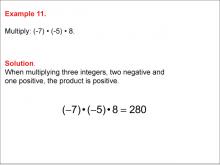
|
Math Example--Numerical Expressions--Multiplying Integers: Example 11 | Math Example--Numerical Expressions--Multiplying Integers: Example 11TopicNumerical Expressions DescriptionExample 11 shows the multiplication of three integers: -7, -5, and 8. The solution demonstrates that when multiplying three integers with two negative numbers and one positive number, the result is positive. In this case, (-7) × (-5) × 8 = 280. |
Numerical Expressions |

|
Math Example--Numerical Expressions--Multiplying Integers: Example 11 | Math Example--Numerical Expressions--Multiplying Integers: Example 11TopicNumerical Expressions DescriptionExample 11 shows the multiplication of three integers: -7, -5, and 8. The solution demonstrates that when multiplying three integers with two negative numbers and one positive number, the result is positive. In this case, (-7) × (-5) × 8 = 280. |
Numerical Expressions |

|
Math Example--Numerical Expressions--Multiplying Integers: Example 11 | Math Example--Numerical Expressions--Multiplying Integers: Example 11TopicNumerical Expressions DescriptionExample 11 shows the multiplication of three integers: -7, -5, and 8. The solution demonstrates that when multiplying three integers with two negative numbers and one positive number, the result is positive. In this case, (-7) × (-5) × 8 = 280. |
Numerical Expressions |

|
Math Example--Numerical Expressions--Multiplying Integers: Example 11 | Math Example--Numerical Expressions--Multiplying Integers: Example 11TopicNumerical Expressions DescriptionExample 11 shows the multiplication of three integers: -7, -5, and 8. The solution demonstrates that when multiplying three integers with two negative numbers and one positive number, the result is positive. In this case, (-7) × (-5) × 8 = 280. |
Numerical Expressions |

|
Math Example--Numerical Expressions--Multiplying Integers: Example 11 | Math Example--Numerical Expressions--Multiplying Integers: Example 11TopicNumerical Expressions DescriptionExample 11 shows the multiplication of three integers: -7, -5, and 8. The solution demonstrates that when multiplying three integers with two negative numbers and one positive number, the result is positive. In this case, (-7) × (-5) × 8 = 280. |
Numerical Expressions |

|
Math Example--Numerical Expressions--Multiplying Integers: Example 11 | Math Example--Numerical Expressions--Multiplying Integers: Example 11TopicNumerical Expressions DescriptionExample 11 shows the multiplication of three integers: -7, -5, and 8. The solution demonstrates that when multiplying three integers with two negative numbers and one positive number, the result is positive. In this case, (-7) × (-5) × 8 = 280. |
Numerical Expressions |

|
Math Example--Numerical Expressions--Multiplying Integers: Example 11 | Math Example--Numerical Expressions--Multiplying Integers: Example 11TopicNumerical Expressions DescriptionExample 11 shows the multiplication of three integers: -7, -5, and 8. The solution demonstrates that when multiplying three integers with two negative numbers and one positive number, the result is positive. In this case, (-7) × (-5) × 8 = 280. |
Numerical Expressions |
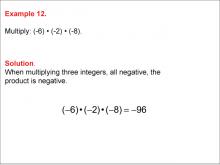
|
Math Example--Numerical Expressions--Multiplying Integers: Example 12 | Math Example--Numerical Expressions--Multiplying Integers: Example 12TopicNumerical Expressions DescriptionExample 12 demonstrates the multiplication of three negative integers: -6, -2, and -8. The solution shows that when multiplying three negative numbers, the result is negative. In this case, (-6) × (-2) × (-8) = -96. This collection of examples covers various scenarios of integer multiplication, helping students understand the rules governing the multiplication of positive and negative numbers. By presenting different combinations of negative integers, students can recognize patterns and develop a solid foundation for more complex mathematical operations. |
Numerical Expressions |

|
Math Example--Numerical Expressions--Multiplying Integers: Example 12 | Math Example--Numerical Expressions--Multiplying Integers: Example 12TopicNumerical Expressions DescriptionExample 12 demonstrates the multiplication of three negative integers: -6, -2, and -8. The solution shows that when multiplying three negative numbers, the result is negative. In this case, (-6) × (-2) × (-8) = -96. This collection of examples covers various scenarios of integer multiplication, helping students understand the rules governing the multiplication of positive and negative numbers. By presenting different combinations of negative integers, students can recognize patterns and develop a solid foundation for more complex mathematical operations. |
Numerical Expressions |

|
Math Example--Numerical Expressions--Multiplying Integers: Example 12 | Math Example--Numerical Expressions--Multiplying Integers: Example 12TopicNumerical Expressions DescriptionExample 12 demonstrates the multiplication of three negative integers: -6, -2, and -8. The solution shows that when multiplying three negative numbers, the result is negative. In this case, (-6) × (-2) × (-8) = -96. This collection of examples covers various scenarios of integer multiplication, helping students understand the rules governing the multiplication of positive and negative numbers. By presenting different combinations of negative integers, students can recognize patterns and develop a solid foundation for more complex mathematical operations. |
Numerical Expressions |

|
Math Example--Numerical Expressions--Multiplying Integers: Example 12 | Math Example--Numerical Expressions--Multiplying Integers: Example 12TopicNumerical Expressions DescriptionExample 12 demonstrates the multiplication of three negative integers: -6, -2, and -8. The solution shows that when multiplying three negative numbers, the result is negative. In this case, (-6) × (-2) × (-8) = -96. This collection of examples covers various scenarios of integer multiplication, helping students understand the rules governing the multiplication of positive and negative numbers. By presenting different combinations of negative integers, students can recognize patterns and develop a solid foundation for more complex mathematical operations. |
Numerical Expressions |

|
Math Example--Numerical Expressions--Multiplying Integers: Example 12 | Math Example--Numerical Expressions--Multiplying Integers: Example 12TopicNumerical Expressions DescriptionExample 12 demonstrates the multiplication of three negative integers: -6, -2, and -8. The solution shows that when multiplying three negative numbers, the result is negative. In this case, (-6) × (-2) × (-8) = -96. This collection of examples covers various scenarios of integer multiplication, helping students understand the rules governing the multiplication of positive and negative numbers. By presenting different combinations of negative integers, students can recognize patterns and develop a solid foundation for more complex mathematical operations. |
Numerical Expressions |

|
Math Example--Numerical Expressions--Multiplying Integers: Example 12 | Math Example--Numerical Expressions--Multiplying Integers: Example 12TopicNumerical Expressions DescriptionExample 12 demonstrates the multiplication of three negative integers: -6, -2, and -8. The solution shows that when multiplying three negative numbers, the result is negative. In this case, (-6) × (-2) × (-8) = -96. This collection of examples covers various scenarios of integer multiplication, helping students understand the rules governing the multiplication of positive and negative numbers. By presenting different combinations of negative integers, students can recognize patterns and develop a solid foundation for more complex mathematical operations. |
Numerical Expressions |

|
Math Example--Numerical Expressions--Multiplying Integers: Example 12 | Math Example--Numerical Expressions--Multiplying Integers: Example 12TopicNumerical Expressions DescriptionExample 12 demonstrates the multiplication of three negative integers: -6, -2, and -8. The solution shows that when multiplying three negative numbers, the result is negative. In this case, (-6) × (-2) × (-8) = -96. This collection of examples covers various scenarios of integer multiplication, helping students understand the rules governing the multiplication of positive and negative numbers. By presenting different combinations of negative integers, students can recognize patterns and develop a solid foundation for more complex mathematical operations. |
Numerical Expressions |

|
Math Example--Numerical Expressions--Multiplying Integers: Example 12 | Math Example--Numerical Expressions--Multiplying Integers: Example 12TopicNumerical Expressions DescriptionExample 12 demonstrates the multiplication of three negative integers: -6, -2, and -8. The solution shows that when multiplying three negative numbers, the result is negative. In this case, (-6) × (-2) × (-8) = -96. This collection of examples covers various scenarios of integer multiplication, helping students understand the rules governing the multiplication of positive and negative numbers. By presenting different combinations of negative integers, students can recognize patterns and develop a solid foundation for more complex mathematical operations. |
Numerical Expressions |
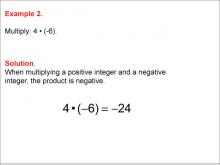
|
Math Example--Numerical Expressions--Multiplying Integers: Example 2 | Math Example--Numerical Expressions--Multiplying Integers: Example 2TopicNumerical Expressions DescriptionExample 2 illustrates the multiplication of a positive integer by a negative integer: 4 × (-6). The solution demonstrates that when multiplying a positive number by a negative number, the result is always negative. In this case, 4 × (-6) = -24. This collection of examples covers various scenarios of integer multiplication, helping students understand the rules governing the multiplication of positive and negative numbers. By presenting different combinations, students can recognize patterns and develop a solid foundation for more complex mathematical operations. |
Numerical Expressions |

|
Math Example--Numerical Expressions--Multiplying Integers: Example 2 | Math Example--Numerical Expressions--Multiplying Integers: Example 2TopicNumerical Expressions DescriptionExample 2 illustrates the multiplication of a positive integer by a negative integer: 4 × (-6). The solution demonstrates that when multiplying a positive number by a negative number, the result is always negative. In this case, 4 × (-6) = -24. This collection of examples covers various scenarios of integer multiplication, helping students understand the rules governing the multiplication of positive and negative numbers. By presenting different combinations, students can recognize patterns and develop a solid foundation for more complex mathematical operations. |
Numerical Expressions |

|
Math Example--Numerical Expressions--Multiplying Integers: Example 2 | Math Example--Numerical Expressions--Multiplying Integers: Example 2TopicNumerical Expressions DescriptionExample 2 illustrates the multiplication of a positive integer by a negative integer: 4 × (-6). The solution demonstrates that when multiplying a positive number by a negative number, the result is always negative. In this case, 4 × (-6) = -24. This collection of examples covers various scenarios of integer multiplication, helping students understand the rules governing the multiplication of positive and negative numbers. By presenting different combinations, students can recognize patterns and develop a solid foundation for more complex mathematical operations. |
Numerical Expressions |

|
Math Example--Numerical Expressions--Multiplying Integers: Example 2 | Math Example--Numerical Expressions--Multiplying Integers: Example 2TopicNumerical Expressions DescriptionExample 2 illustrates the multiplication of a positive integer by a negative integer: 4 × (-6). The solution demonstrates that when multiplying a positive number by a negative number, the result is always negative. In this case, 4 × (-6) = -24. This collection of examples covers various scenarios of integer multiplication, helping students understand the rules governing the multiplication of positive and negative numbers. By presenting different combinations, students can recognize patterns and develop a solid foundation for more complex mathematical operations. |
Numerical Expressions |

|
Math Example--Numerical Expressions--Multiplying Integers: Example 2 | Math Example--Numerical Expressions--Multiplying Integers: Example 2TopicNumerical Expressions DescriptionExample 2 illustrates the multiplication of a positive integer by a negative integer: 4 × (-6). The solution demonstrates that when multiplying a positive number by a negative number, the result is always negative. In this case, 4 × (-6) = -24. This collection of examples covers various scenarios of integer multiplication, helping students understand the rules governing the multiplication of positive and negative numbers. By presenting different combinations, students can recognize patterns and develop a solid foundation for more complex mathematical operations. |
Numerical Expressions |

|
Math Example--Numerical Expressions--Multiplying Integers: Example 2 | Math Example--Numerical Expressions--Multiplying Integers: Example 2TopicNumerical Expressions DescriptionExample 2 illustrates the multiplication of a positive integer by a negative integer: 4 × (-6). The solution demonstrates that when multiplying a positive number by a negative number, the result is always negative. In this case, 4 × (-6) = -24. This collection of examples covers various scenarios of integer multiplication, helping students understand the rules governing the multiplication of positive and negative numbers. By presenting different combinations, students can recognize patterns and develop a solid foundation for more complex mathematical operations. |
Numerical Expressions |

|
Math Example--Numerical Expressions--Multiplying Integers: Example 2 | Math Example--Numerical Expressions--Multiplying Integers: Example 2TopicNumerical Expressions DescriptionExample 2 illustrates the multiplication of a positive integer by a negative integer: 4 × (-6). The solution demonstrates that when multiplying a positive number by a negative number, the result is always negative. In this case, 4 × (-6) = -24. This collection of examples covers various scenarios of integer multiplication, helping students understand the rules governing the multiplication of positive and negative numbers. By presenting different combinations, students can recognize patterns and develop a solid foundation for more complex mathematical operations. |
Numerical Expressions |

|
Math Example--Numerical Expressions--Multiplying Integers: Example 2 | Math Example--Numerical Expressions--Multiplying Integers: Example 2TopicNumerical Expressions DescriptionExample 2 illustrates the multiplication of a positive integer by a negative integer: 4 × (-6). The solution demonstrates that when multiplying a positive number by a negative number, the result is always negative. In this case, 4 × (-6) = -24. This collection of examples covers various scenarios of integer multiplication, helping students understand the rules governing the multiplication of positive and negative numbers. By presenting different combinations, students can recognize patterns and develop a solid foundation for more complex mathematical operations. |
Numerical Expressions |
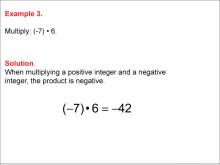
|
Math Example--Numerical Expressions--Multiplying Integers: Example 3 | Math Example--Numerical Expressions--Multiplying Integers: Example 3TopicNumerical Expressions DescriptionExample 3 demonstrates the multiplication of a negative integer by a positive integer: (-7) × 6. The solution shows that when multiplying a negative number by a positive number, the result is always negative. In this case, (-7) × 6 = -42. This collection of examples explores various scenarios of integer multiplication, helping students understand the rules governing the multiplication of positive and negative numbers. By presenting different combinations, students can recognize patterns and develop a solid foundation for more complex mathematical operations. |
Numerical Expressions |

|
Math Example--Numerical Expressions--Multiplying Integers: Example 3 | Math Example--Numerical Expressions--Multiplying Integers: Example 3TopicNumerical Expressions DescriptionExample 3 demonstrates the multiplication of a negative integer by a positive integer: (-7) × 6. The solution shows that when multiplying a negative number by a positive number, the result is always negative. In this case, (-7) × 6 = -42. This collection of examples explores various scenarios of integer multiplication, helping students understand the rules governing the multiplication of positive and negative numbers. By presenting different combinations, students can recognize patterns and develop a solid foundation for more complex mathematical operations. |
Numerical Expressions |

|
Math Example--Numerical Expressions--Multiplying Integers: Example 3 | Math Example--Numerical Expressions--Multiplying Integers: Example 3TopicNumerical Expressions DescriptionExample 3 demonstrates the multiplication of a negative integer by a positive integer: (-7) × 6. The solution shows that when multiplying a negative number by a positive number, the result is always negative. In this case, (-7) × 6 = -42. This collection of examples explores various scenarios of integer multiplication, helping students understand the rules governing the multiplication of positive and negative numbers. By presenting different combinations, students can recognize patterns and develop a solid foundation for more complex mathematical operations. |
Numerical Expressions |

|
Math Example--Numerical Expressions--Multiplying Integers: Example 3 | Math Example--Numerical Expressions--Multiplying Integers: Example 3TopicNumerical Expressions DescriptionExample 3 demonstrates the multiplication of a negative integer by a positive integer: (-7) × 6. The solution shows that when multiplying a negative number by a positive number, the result is always negative. In this case, (-7) × 6 = -42. This collection of examples explores various scenarios of integer multiplication, helping students understand the rules governing the multiplication of positive and negative numbers. By presenting different combinations, students can recognize patterns and develop a solid foundation for more complex mathematical operations. |
Numerical Expressions |

|
Math Example--Numerical Expressions--Multiplying Integers: Example 3 | Math Example--Numerical Expressions--Multiplying Integers: Example 3TopicNumerical Expressions DescriptionExample 3 demonstrates the multiplication of a negative integer by a positive integer: (-7) × 6. The solution shows that when multiplying a negative number by a positive number, the result is always negative. In this case, (-7) × 6 = -42. This collection of examples explores various scenarios of integer multiplication, helping students understand the rules governing the multiplication of positive and negative numbers. By presenting different combinations, students can recognize patterns and develop a solid foundation for more complex mathematical operations. |
Numerical Expressions |

|
Math Example--Numerical Expressions--Multiplying Integers: Example 3 | Math Example--Numerical Expressions--Multiplying Integers: Example 3TopicNumerical Expressions DescriptionExample 3 demonstrates the multiplication of a negative integer by a positive integer: (-7) × 6. The solution shows that when multiplying a negative number by a positive number, the result is always negative. In this case, (-7) × 6 = -42. This collection of examples explores various scenarios of integer multiplication, helping students understand the rules governing the multiplication of positive and negative numbers. By presenting different combinations, students can recognize patterns and develop a solid foundation for more complex mathematical operations. |
Numerical Expressions |

|
Math Example--Numerical Expressions--Multiplying Integers: Example 3 | Math Example--Numerical Expressions--Multiplying Integers: Example 3TopicNumerical Expressions DescriptionExample 3 demonstrates the multiplication of a negative integer by a positive integer: (-7) × 6. The solution shows that when multiplying a negative number by a positive number, the result is always negative. In this case, (-7) × 6 = -42. This collection of examples explores various scenarios of integer multiplication, helping students understand the rules governing the multiplication of positive and negative numbers. By presenting different combinations, students can recognize patterns and develop a solid foundation for more complex mathematical operations. |
Numerical Expressions |

|
Math Example--Numerical Expressions--Multiplying Integers: Example 3 | Math Example--Numerical Expressions--Multiplying Integers: Example 3TopicNumerical Expressions DescriptionExample 3 demonstrates the multiplication of a negative integer by a positive integer: (-7) × 6. The solution shows that when multiplying a negative number by a positive number, the result is always negative. In this case, (-7) × 6 = -42. This collection of examples explores various scenarios of integer multiplication, helping students understand the rules governing the multiplication of positive and negative numbers. By presenting different combinations, students can recognize patterns and develop a solid foundation for more complex mathematical operations. |
Numerical Expressions |
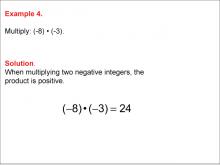
|
Math Example--Numerical Expressions--Multiplying Integers: Example 4 | Math Example--Numerical Expressions--Multiplying Integers: Example 4TopicNumerical Expressions DescriptionExample 4 shows the multiplication of two negative integers: (-8) × (-3). The solution demonstrates that when multiplying two negative numbers, the result is always positive. In this case, (-8) × (-3) = 24. This collection of examples covers various scenarios of integer multiplication, helping students understand the rules governing the multiplication of positive and negative numbers. By presenting different combinations, students can recognize patterns and develop a solid foundation for more complex mathematical operations. |
Numerical Expressions |

|
Math Example--Numerical Expressions--Multiplying Integers: Example 4 | Math Example--Numerical Expressions--Multiplying Integers: Example 4TopicNumerical Expressions DescriptionExample 4 shows the multiplication of two negative integers: (-8) × (-3). The solution demonstrates that when multiplying two negative numbers, the result is always positive. In this case, (-8) × (-3) = 24. This collection of examples covers various scenarios of integer multiplication, helping students understand the rules governing the multiplication of positive and negative numbers. By presenting different combinations, students can recognize patterns and develop a solid foundation for more complex mathematical operations. |
Numerical Expressions |

|
Math Example--Numerical Expressions--Multiplying Integers: Example 4 | Math Example--Numerical Expressions--Multiplying Integers: Example 4TopicNumerical Expressions DescriptionExample 4 shows the multiplication of two negative integers: (-8) × (-3). The solution demonstrates that when multiplying two negative numbers, the result is always positive. In this case, (-8) × (-3) = 24. This collection of examples covers various scenarios of integer multiplication, helping students understand the rules governing the multiplication of positive and negative numbers. By presenting different combinations, students can recognize patterns and develop a solid foundation for more complex mathematical operations. |
Numerical Expressions |

|
Math Example--Numerical Expressions--Multiplying Integers: Example 4 | Math Example--Numerical Expressions--Multiplying Integers: Example 4TopicNumerical Expressions DescriptionExample 4 shows the multiplication of two negative integers: (-8) × (-3). The solution demonstrates that when multiplying two negative numbers, the result is always positive. In this case, (-8) × (-3) = 24. This collection of examples covers various scenarios of integer multiplication, helping students understand the rules governing the multiplication of positive and negative numbers. By presenting different combinations, students can recognize patterns and develop a solid foundation for more complex mathematical operations. |
Numerical Expressions |

|
Math Example--Numerical Expressions--Multiplying Integers: Example 4 | Math Example--Numerical Expressions--Multiplying Integers: Example 4TopicNumerical Expressions DescriptionExample 4 shows the multiplication of two negative integers: (-8) × (-3). The solution demonstrates that when multiplying two negative numbers, the result is always positive. In this case, (-8) × (-3) = 24. This collection of examples covers various scenarios of integer multiplication, helping students understand the rules governing the multiplication of positive and negative numbers. By presenting different combinations, students can recognize patterns and develop a solid foundation for more complex mathematical operations. |
Numerical Expressions |

|
Math Example--Numerical Expressions--Multiplying Integers: Example 4 | Math Example--Numerical Expressions--Multiplying Integers: Example 4TopicNumerical Expressions DescriptionExample 4 shows the multiplication of two negative integers: (-8) × (-3). The solution demonstrates that when multiplying two negative numbers, the result is always positive. In this case, (-8) × (-3) = 24. This collection of examples covers various scenarios of integer multiplication, helping students understand the rules governing the multiplication of positive and negative numbers. By presenting different combinations, students can recognize patterns and develop a solid foundation for more complex mathematical operations. |
Numerical Expressions |

|
Math Example--Numerical Expressions--Multiplying Integers: Example 4 | Math Example--Numerical Expressions--Multiplying Integers: Example 4TopicNumerical Expressions DescriptionExample 4 shows the multiplication of two negative integers: (-8) × (-3). The solution demonstrates that when multiplying two negative numbers, the result is always positive. In this case, (-8) × (-3) = 24. This collection of examples covers various scenarios of integer multiplication, helping students understand the rules governing the multiplication of positive and negative numbers. By presenting different combinations, students can recognize patterns and develop a solid foundation for more complex mathematical operations. |
Numerical Expressions |

|
Math Example--Numerical Expressions--Multiplying Integers: Example 4 | Math Example--Numerical Expressions--Multiplying Integers: Example 4TopicNumerical Expressions DescriptionExample 4 shows the multiplication of two negative integers: (-8) × (-3). The solution demonstrates that when multiplying two negative numbers, the result is always positive. In this case, (-8) × (-3) = 24. This collection of examples covers various scenarios of integer multiplication, helping students understand the rules governing the multiplication of positive and negative numbers. By presenting different combinations, students can recognize patterns and develop a solid foundation for more complex mathematical operations. |
Numerical Expressions |
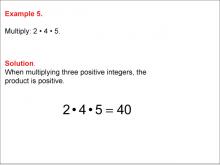
|
Math Example--Numerical Expressions--Multiplying Integers: Example 5 | Math Example--Numerical Expressions--Multiplying Integers: Example 5TopicNumerical Expressions DescriptionExample 5 illustrates the multiplication of three positive integers: 2 × 4 × 5. The solution demonstrates that when multiplying multiple positive numbers, the result remains positive. In this case, 2 × 4 × 5 = 40. This collection of examples explores various scenarios of integer multiplication, helping students understand the rules governing the multiplication of positive and negative numbers. By presenting different combinations, including multiple factors, students can recognize patterns and develop a solid foundation for more complex mathematical operations. |
Numerical Expressions |

|
Math Example--Numerical Expressions--Multiplying Integers: Example 5 | Math Example--Numerical Expressions--Multiplying Integers: Example 5TopicNumerical Expressions DescriptionExample 5 illustrates the multiplication of three positive integers: 2 × 4 × 5. The solution demonstrates that when multiplying multiple positive numbers, the result remains positive. In this case, 2 × 4 × 5 = 40. This collection of examples explores various scenarios of integer multiplication, helping students understand the rules governing the multiplication of positive and negative numbers. By presenting different combinations, including multiple factors, students can recognize patterns and develop a solid foundation for more complex mathematical operations. |
Numerical Expressions |

|
Math Example--Numerical Expressions--Multiplying Integers: Example 5 | Math Example--Numerical Expressions--Multiplying Integers: Example 5TopicNumerical Expressions DescriptionExample 5 illustrates the multiplication of three positive integers: 2 × 4 × 5. The solution demonstrates that when multiplying multiple positive numbers, the result remains positive. In this case, 2 × 4 × 5 = 40. This collection of examples explores various scenarios of integer multiplication, helping students understand the rules governing the multiplication of positive and negative numbers. By presenting different combinations, including multiple factors, students can recognize patterns and develop a solid foundation for more complex mathematical operations. |
Numerical Expressions |

|
Math Example--Numerical Expressions--Multiplying Integers: Example 5 | Math Example--Numerical Expressions--Multiplying Integers: Example 5TopicNumerical Expressions DescriptionExample 5 illustrates the multiplication of three positive integers: 2 × 4 × 5. The solution demonstrates that when multiplying multiple positive numbers, the result remains positive. In this case, 2 × 4 × 5 = 40. This collection of examples explores various scenarios of integer multiplication, helping students understand the rules governing the multiplication of positive and negative numbers. By presenting different combinations, including multiple factors, students can recognize patterns and develop a solid foundation for more complex mathematical operations. |
Numerical Expressions |

|
Math Example--Numerical Expressions--Multiplying Integers: Example 5 | Math Example--Numerical Expressions--Multiplying Integers: Example 5TopicNumerical Expressions DescriptionExample 5 illustrates the multiplication of three positive integers: 2 × 4 × 5. The solution demonstrates that when multiplying multiple positive numbers, the result remains positive. In this case, 2 × 4 × 5 = 40. This collection of examples explores various scenarios of integer multiplication, helping students understand the rules governing the multiplication of positive and negative numbers. By presenting different combinations, including multiple factors, students can recognize patterns and develop a solid foundation for more complex mathematical operations. |
Numerical Expressions |

|
Math Example--Numerical Expressions--Multiplying Integers: Example 5 | Math Example--Numerical Expressions--Multiplying Integers: Example 5TopicNumerical Expressions DescriptionExample 5 illustrates the multiplication of three positive integers: 2 × 4 × 5. The solution demonstrates that when multiplying multiple positive numbers, the result remains positive. In this case, 2 × 4 × 5 = 40. This collection of examples explores various scenarios of integer multiplication, helping students understand the rules governing the multiplication of positive and negative numbers. By presenting different combinations, including multiple factors, students can recognize patterns and develop a solid foundation for more complex mathematical operations. |
Numerical Expressions |

|
Math Example--Numerical Expressions--Multiplying Integers: Example 5 | Math Example--Numerical Expressions--Multiplying Integers: Example 5TopicNumerical Expressions DescriptionExample 5 illustrates the multiplication of three positive integers: 2 × 4 × 5. The solution demonstrates that when multiplying multiple positive numbers, the result remains positive. In this case, 2 × 4 × 5 = 40. This collection of examples explores various scenarios of integer multiplication, helping students understand the rules governing the multiplication of positive and negative numbers. By presenting different combinations, including multiple factors, students can recognize patterns and develop a solid foundation for more complex mathematical operations. |
Numerical Expressions |

|
Math Example--Numerical Expressions--Multiplying Integers: Example 5 | Math Example--Numerical Expressions--Multiplying Integers: Example 5TopicNumerical Expressions DescriptionExample 5 illustrates the multiplication of three positive integers: 2 × 4 × 5. The solution demonstrates that when multiplying multiple positive numbers, the result remains positive. In this case, 2 × 4 × 5 = 40. This collection of examples explores various scenarios of integer multiplication, helping students understand the rules governing the multiplication of positive and negative numbers. By presenting different combinations, including multiple factors, students can recognize patterns and develop a solid foundation for more complex mathematical operations. |
Numerical Expressions |
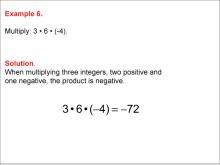
|
Math Example--Numerical Expressions--Multiplying Integers: Example 6 | Math Example--Numerical Expressions--Multiplying Integers: Example 6TopicNumerical Expressions DescriptionExample 6 demonstrates the multiplication of three integers, including a negative number: 3 × 6 × (-4). The solution shows that when multiplying multiple numbers with one negative factor, the result is negative. In this case, 3 × 6 × (-4) = -72. |
Numerical Expressions |

|
Math Example--Numerical Expressions--Multiplying Integers: Example 6 | Math Example--Numerical Expressions--Multiplying Integers: Example 6TopicNumerical Expressions DescriptionExample 6 demonstrates the multiplication of three integers, including a negative number: 3 × 6 × (-4). The solution shows that when multiplying multiple numbers with one negative factor, the result is negative. In this case, 3 × 6 × (-4) = -72. |
Numerical Expressions |

|
Math Example--Numerical Expressions--Multiplying Integers: Example 6 | Math Example--Numerical Expressions--Multiplying Integers: Example 6TopicNumerical Expressions DescriptionExample 6 demonstrates the multiplication of three integers, including a negative number: 3 × 6 × (-4). The solution shows that when multiplying multiple numbers with one negative factor, the result is negative. In this case, 3 × 6 × (-4) = -72. |
Numerical Expressions |